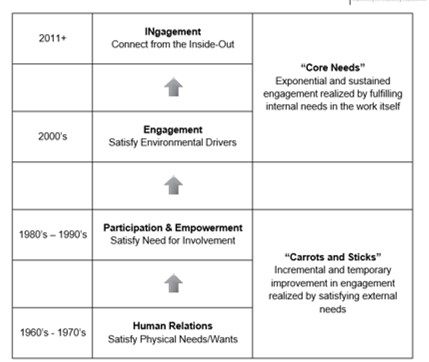Many companies' engagement activities have hit a wall. At best they are experiencing incremental improvement, yet employees' level of motivation and engagement is still lacking. The answer is to start looking on the inside or what we call INgagement.
INgagement vs Engagement?
Engagement is typically defined as the level of discretionary effort that an employee brings to their work and career. Over the last few decades, companies have invested significant time and resources to measure and influence employee engagement. For most of our clients, these efforts had immediate benefits, however, over the years their engagement efforts have hit a wall with measured engagement not improving year-over-year, and even sliding back in some cases.
Why is this?
The largest reason is because engagement activities focus on the external aspects of employee motivation – things such as communication, direct management behaviors, rewards and pay.
Utilizing the INgagement concept and approach, companies move beyond employee “engagement”, in which career motivation is largely driven by external factors outside your control (money, manager, and recognition) and move into INgagement, in which employees are continually having their needs met by the work itself.
Company INgagement
Organizations build sustained employee engagement – moving beyond carrots and sticks, companies can deploy a systemic process for aligning people’s core needs with their work. The outcome of this process is a systemic multiplier in employee energy, engagement, and performance as companies give employees the method and tools to own their career and work– to align and focus their core passions for the good of the company.
Beyond Engagement to INgagement
The field of employee motivation and productivity has followed a clear path to INgagement.

I am Human
In the 1960’s and 1970’s there was the emergence of the Human Relations school of management, which focused on providing a fair wage and benefits. The belief was employees would be more loyal and productive if they were simply paid well and treated equitably. An outgrowth of this movement includes the incentive systems (e.g. bonuses and pay for performance) that are continue to this day. By the end of the 1970's the impact of the Human Relations had been pervasive and positive. However, there was clearly still a need and opportunity to more fully leverage human capital.
Include Me . . . Please
In the 1980’s and 1990’s the answer to higher motivation and productivity was found in heavy doses of participation and empowerment. The prevailing belief was as people were given the right level of input and authority over their work, they would in-turn provide greater effort and better solutions. This philosophy saw the emergence of Quality Circles, Self-Directed Work
Teams, and books such as The One Minute Manager. The impact of the participation and empowerment movement was profound, and is still at the cornerstone of progressive leaders and companies. However, participation and empowerment only took organizations to a certain point. Companies and employees still wanted and needed more.
Moving into the new millennium, we saw the emergence of the concept of Engagement – usually defined as an employee’s level of discretionary effort and intent to stay with the company. Research has shown that there are multiple factors, or “drivers”, behind employee engagement. By measuring these drivers through surveys, companies were able to quantify the level of employee engagement and productivity. Many companies showed commitment to the process – investing in annual surveys and extensive action planning. Generally, these same companies realized year-over-year improvement for some years, but eventually their results stagnated – company engagement hit a wall.
The pressure to improve employee satisfaction, engagement, and loyalty has not gone away. However, the line of approaches have run their course. In focusing on the external conditions in which an employee works, the above solutions have missed the real source of engagement – the work itself. How much an employee is paid, how effectively they are empowered, or how often they are asked their opinion is simply window dressing. What matters is how much they love the work they do. Even the best paid, most involved employee in a highly engaged environment will not have sustained motivation if he or she dislikes the content of their job.
INgagement - I Love My Job
Beyond pay, benefits, a particular style of management, or any set of engagement actions, the phrase that is most correlated with company loyalty and performance is “I love my job”. People love their job when their core needs are being fulfilled. Everyone’s core needs are different and we are generally unaware of our core needs. A person is INgaged when they understand what they need in their career, and frame a job to meet those needs.
Simply put, INgaging a person unleashes their energy, changing their career and even their life. INgaging a team, department or company provides a unique competitive advantage – what if you and everyone your department truly loved their job?



